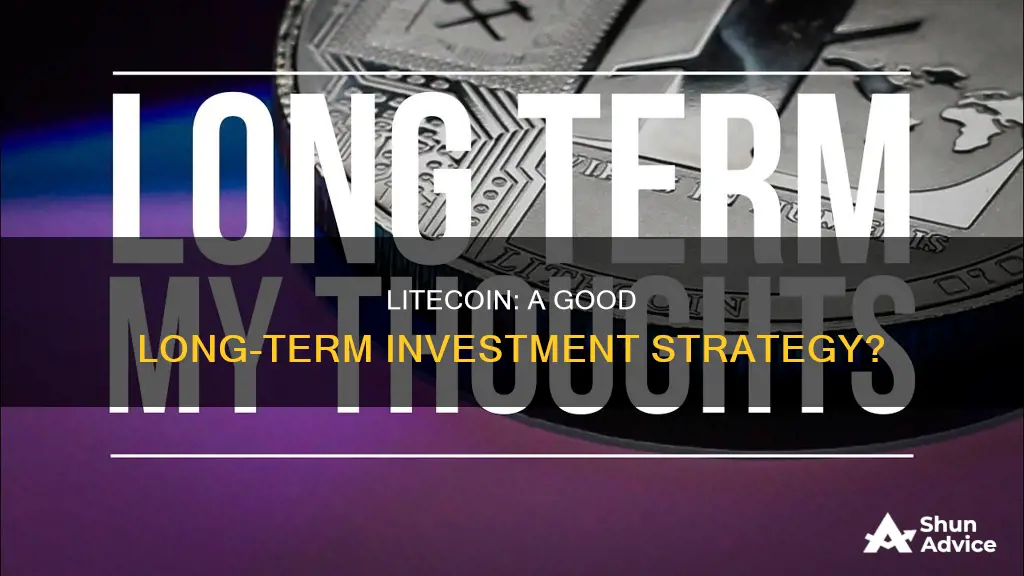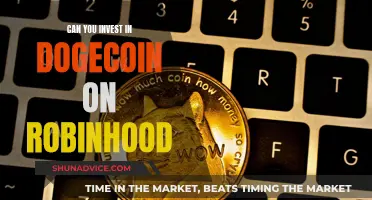
Litecoin is a cryptocurrency that has been around for a while now, having been introduced in 2011. It is often referred to as digital silver to Bitcoin's digital gold. Litecoin has a lot of similarities with Bitcoin, including a hard-capped supply, but it also has some key differences, such as lower transaction fees and faster transaction times. Over the years, Litecoin has had its ups and downs, with its price fluctuating dramatically. While it has proven to be a good investment for some, there are also risks associated with investing in Litecoin, and its future is uncertain. So, is Litecoin a good long-term investment? Let's explore the topic further and weigh the pros and cons.
| Characteristics | Values |
|---|---|
| Price | $63.83 per LTC |
| Market Cap | $4,783,134,158 USD |
| 24-hour Trading Volume | $224,546,604 USD |
| Circulating Supply | 74,927,593 LTC |
| Transaction Fees | $0.04 |
| Block Generation Time | 2.5 minutes |
| Maximum Supply | 84,000,000 LTC |
| Circulating Supply | 66,752,415 LTC |
| Ledger Size | 4x that of Bitcoin |
| Risk Profile | High risk |
What You'll Learn

Litecoin's historical performance
Litecoin's opening price was around 30 cents. It reached an all-time high of $417 in 2017, before falling to $20 in 2018. In 2019, Litecoin experienced its strongest year, fuelled by its halving event, and soared by 600% before retracing back to its bear market bottom. In 2020, Litecoin rallied, and in 2021, it attempted to set a new high, but the results were mixed.
In 2022, Litecoin set a higher high, marking the first time since its all-time price record in 2017. However, as the “crypto winter” set in, Litecoin was a victim, and its price fell. As of 2023, Litecoin has been trading under $100 and even saw $50.
Litecoin has had explosive returns in the past, but its performance has been volatile. It has failed to perform as well as Bitcoin after its halving event, and it has struggled over the last several years, with an average trading price between $60 and $70 in 2023.
Despite the corrections and potential top formation, Litecoin has a strong long-term price trajectory and outlook. Its price is expected to rise in the coming years, with some experts predicting it will reach $1,000 or more in the long term.
Best Bitcoins to Invest: Top Crypto Picks
You may want to see also

Litecoin's advantages over Bitcoin
Litecoin is often referred to as digital silver to Bitcoin's digital gold. Both are cryptocurrencies with several similarities, but there are some key differences that give Litecoin an advantage over Bitcoin.
Transaction Speed
Litecoin's average transaction time is 2.5 minutes, four times faster than Bitcoin's 10 minutes. This is because Litecoin's mining algorithm, Scrypt, is newer and more efficient than the SHA-256 algorithm used by Bitcoin. The faster transaction speed makes Litecoin a better currency for spending.
Transaction Costs
Litecoin has lower transaction costs than Bitcoin.
Mining
Litecoin can be mined using normal computers, whereas Bitcoin requires specialised computers (ASIC miners). This makes Litecoin more democratic because more people can get involved.
Store of Value
Both Bitcoin and Litecoin have limited supplies, which could make them good stores of value. However, Bitcoin is the oldest and most trusted cryptocurrency, and it will reach its supply limit before Litecoin. Therefore, Bitcoin is likely to become a long-term store of value before Litecoin.
Investment
Litecoin is newer than Bitcoin and could still become as popular. Its growth has been slow but steady, and it has proven itself to be reliable and a survivor.
Bitcoin: Should You Invest in the Crypto Craze?
You may want to see also

Litecoin's disadvantages compared to other altcoins
Litecoin is often referred to as "digital silver" to Bitcoin's "digital gold". It was created by Charlie "Satoshi Lite" Lee, a former Google employee, and launched in 2011. It is one of the oldest cryptocurrencies and has been a top-performing altcoin since its inception. However, it has some disadvantages when compared to other altcoins.
Firstly, Litecoin remains an unpopular cryptocurrency. Despite being one of the top ten cryptocurrencies by market capitalization, it lags far behind Bitcoin, Ethereum, and Cardano. It was intended to be a lighter alternative to Bitcoin, but it struggles to maintain its ranking and has occasionally slipped further. The general public and investors view Ethereum as the true primary alternative. Even Litecoin's creator, Charlie Lee, sold all his coins in 2017, and the market share has been shrinking. It is also not as widely accepted as the top three cryptocurrencies, with several currency and cryptocurrency exchange platforms excluding it from their list of tradable currencies.
Secondly, the use of the scrypt algorithm in Litecoin's mining process is counterproductive. The scrypt function was introduced to make mining more accessible by reducing the resource requirements of the blockchain platform. However, it is more complicated and expensive to design and deploy FPGA and ASIC devices for Litecoin mining compared to Bitcoin mining due to the use of the scrypt algorithm. This goes against the theoretical upside of using scrypt to make cryptocurrency mining more accessible.
Thirdly, as a cryptocurrency based on blockchain technology, Litecoin inherits the disadvantages associated with blockchain. These include energy intensiveness due to the computing and cooling requirements of miners, possible negative environmental impacts, and the drawbacks of decentralization. Decentralization can make data modification difficult as the ledger is distributed across a peer-to-peer network. Additionally, the network responsible for processing transactions must remain synchronized for transactions to go through.
Lastly, Litecoin has struggled to perform as well as Bitcoin following its halving events. Bitcoin typically sees an increase in demand and price after halving due to reduced supply. In contrast, Litecoin has seen minimal price surges and has failed to set new all-time highs, indicating that it remains in a bear market.
While Litecoin has advantages such as faster transaction speeds and lower fees compared to Bitcoin, these disadvantages highlight some of the challenges it faces in comparison to other altcoins in the market.
The Ultimate Guide to Investing and Earning with Bitcoin
You may want to see also

The impact of leadership on Litecoin's future
Leadership has played a crucial role in Litecoin's past and will continue to do so in the future.
Litecoin was founded by Charlie Lee, a former Google employee and ex-engineer at Coinbase. Lee's leadership has been instrumental in the development and growth of Litecoin. He is a controversial figure in the cryptocurrency space, known for selling off his Litecoin holdings at the peak of the last crypto bubble. However, Lee cited that the move was done to alleviate a potential conflict of interest.
Lee remains heavily involved in the project and is the Managing Director of the Litecoin Foundation, a team dedicated to pushing Litecoin adoption, increasing its value proposition, and establishing long-term growth. His leadership and influence have helped steer the direction of Litecoin and solidifying its spot as a preferred option for savvy crypto investors.
The Litecoin Foundation plays a significant role in the development and adoption of Litecoin. They work on forming partnerships, funding opportunities, and fostering the Litecoin community. The foundation has also hired developers to improve Litecoin's functionality and user-friendliness, contributing to the coin's long-term sustainability and potential.
Leadership has also been evident in Litecoin's ability to adapt and improve its technology. For example, Litecoin was the first crypto asset to successfully improve transaction speeds compared to Bitcoin. Additionally, it was the first of the major cryptocurrencies to adopt the Segregated Witness (SegWit) system, increasing the block size limit of the blockchain.
While leadership has been a strength for Litecoin so far, it is essential to recognize that the crypto market is highly volatile and subject to various internal and external factors. Leadership can only do so much, and broader market trends, regulatory changes, and consumer sentiment will also play a role in shaping Litecoin's future.
The Wild Ride of Investing in Bitcoin
You may want to see also

How to invest in Litecoin
Investing in Litecoin can be done by mining it or buying it online. Here are some of the most common ways to invest in Litecoin.
Buying and Holding Litecoin
This strategy involves purchasing Litecoin on a spot exchange and moving it to a web or hardware crypto wallet for safekeeping. This is the least effort-intensive and risk-averse strategy, as it forgoes significant risks and does not require much expertise.
Spot Trading
Spot trading involves buying Litecoin at low prices and selling it when prices rise. The aim is to gain as much as possible from each price swing. However, one of the major drawbacks is that you cannot profit from drops in price.
Derivatives Trading
Derivatives trading is an alternative to spot trading that allows traders to go long or short on an asset, often with leverage, amplifying gains. This strategy provides opportunities to profit regardless of market direction but increases risk, so money management is crucial.
Where to Buy Litecoin
There are several platforms and exchanges where you can buy Litecoin, including:
- Coinbase: A popular and trusted platform where you can buy Litecoin with various payment methods, including bank accounts, debit cards, wire transfers, and PayPal (for US customers only).
- Kraken: A secure and trusted crypto exchange that offers a simple interface and the lowest fees in the industry.
- Crypto ATMs: You can locate a crypto ATM that offers LTC, but the rates can be exorbitant, and finding a counterpart to trade with is not guaranteed.
- Direct Purchase: You can purchase Litecoin directly from another individual in person or over the web.
The Day I Lost My Bitcoin Investments: A Cautionary Tale
You may want to see also
Frequently asked questions
Litecoin is a good long-term investment if you are willing to take the plunge. It has been a top-performing altcoin since its inception and has a market capitalization of $5 billion. It is often a leading indicator of the rest of the Crypto market.
Litecoin is a Cryptocurrency token trading under the ticker symbol LTC. It was created by Charlie “Satoshi Lite” Lee, a former Google employee and an engineer at Coinbase.
Litecoin's network batches transactions into blocks every 2.5 minutes, instead of 10. This means lower transaction costs and faster transfer speeds when compared to Bitcoin's mainnet.
Some advantages of investing in Litecoin are lower transaction costs, faster transaction speeds, an open-source platform, and recognizability.
Some disadvantages of investing in Litecoin are competing altcoins that offer similar benefits, less security, and shaky faith in leadership.







